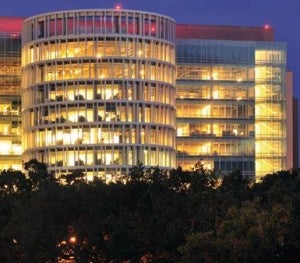
The BioScience Research Collaborative (BRC) is an innovative space where scientists and educators from Rice University and its neighbors in the Texas Medical Center can come together to conduct collaborative research to improve human health through science. Indeed, the entire focus of the BRC — from initial concept to finished layout — has been to catalyze just such interactions. Thoughtfully designed to facilitate research relationships across both organizational and disciplinary boundaries, the BRC brings together some of the most creative life sciences and medical researchers in the world. Individual investigators thus have an unparalleled opportunity to work with any number of colleagues and to form research teams that comprise just the right mix of expertise and experience for any given research project. It is these robust research collaborations that spark the innovative ideas that lead to scientific and medical breakthroughs.
A research catalyst
The BRC is located immediately adjacent to the Texas Medical Center, the largest center of its kind in the world. The TMC encompasses the University of Texas Health Science Center at Houston, the M.D. Anderson Cancer Center, the Baylor College of Medicine, the Texas Children’s Hospital, the Houston Methodist Hospital, the Methodist Research Institute, and the Texas A&M University Institute for BioTechnology, among others. With its close proximity to the Texas Medical Center, the BRC is optimally located to promote long-term strategic partnerships and to serve as a hub where researchers can come together to seek answers to some of the most perplexing — and pressing — questions in the life sciences and medicine.
A translational think tank and research incubator
Importantly, the BRC’s reach extends beyond the Texas Medical Center to include interactions with Houston’s thriving biotechnology industry, as well as with the State of Texas. As industry and government partners move into the building, they find the BRC to be an exceptionally robust research incubator, one that offers them access to the specialized expertise, services, and equipment needed to translate promising ideas in basic life sciences and medical research into applied technologies that can be transferred into the clinical setting.
A state-of-the-art research facility
Completed in 2009 at a cost of $300 million, the BRC confirms Rice’s philosophical and financial commitment to the kind of multidisciplinary research and education programs that strengthen the University’s ties to the life sciences and medicine. The building comprises 10 floors and 414,075 net square feet, and is fully equipped for research in biochemistry, biological chemistry, and metabolic engineering; biophysics and structural biology; cell, cancer, and developmental biology; microbiology; molecular genetics; neurobiology; bioengineering; and signal transduction. Additional features include collaborative common space; custom-designed research laboratories; state-of-the-art classrooms; a 287-seat auditorium; a 90-seat seminar room; extensive computational facilities; specialized facilities for animal care, tissue culture, polymer synthesis, genetic experiments, and growth and harvesting of microorganisms; and space to accommodate a visualization center.
A valuable R&D resource
Because Rice’s Shared Equipment Authority administers guidelines for equipment usage in the BRC and operates and maintains that equipment, investigators located in the building can be confident that they will have ample access to shared research equipment and that this equipment will be well maintained. These services are complemented by the BRC’s in-house library facilities. Taken together, these specialized resources offer significant value to investigators. They free researchers to devote their time and attention to what they do best: form collaborations, conduct research, and translate that research into new technologies that can be used to improve the nation’s health.
Sources: BRC, http://www.rice.edu/brc/; BRC Summary Report, 2011-2013.
Last updated: February 2020.
